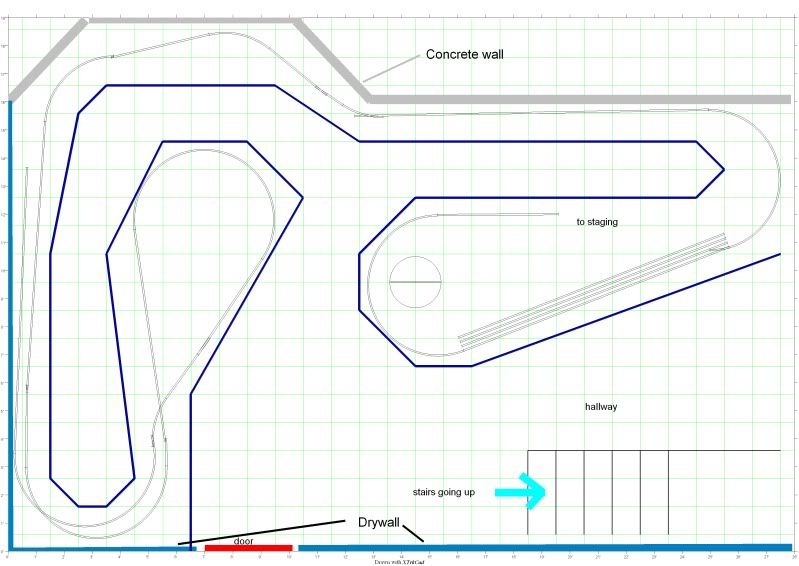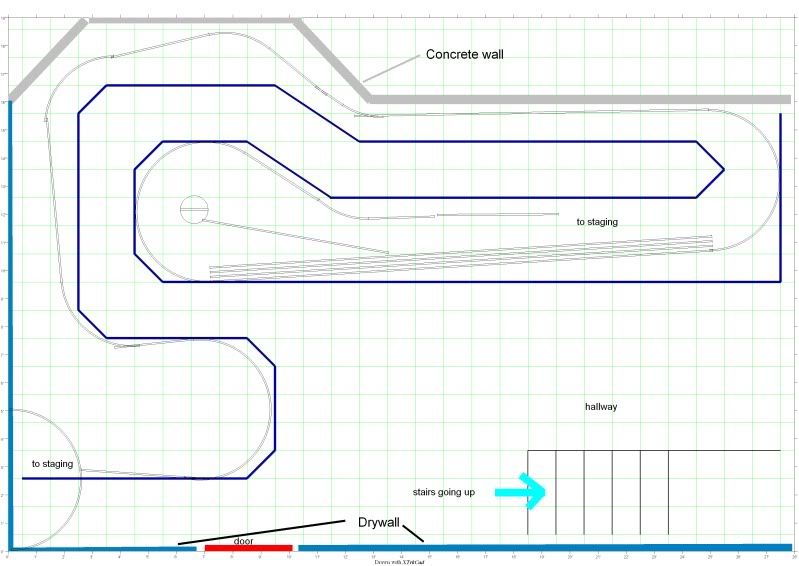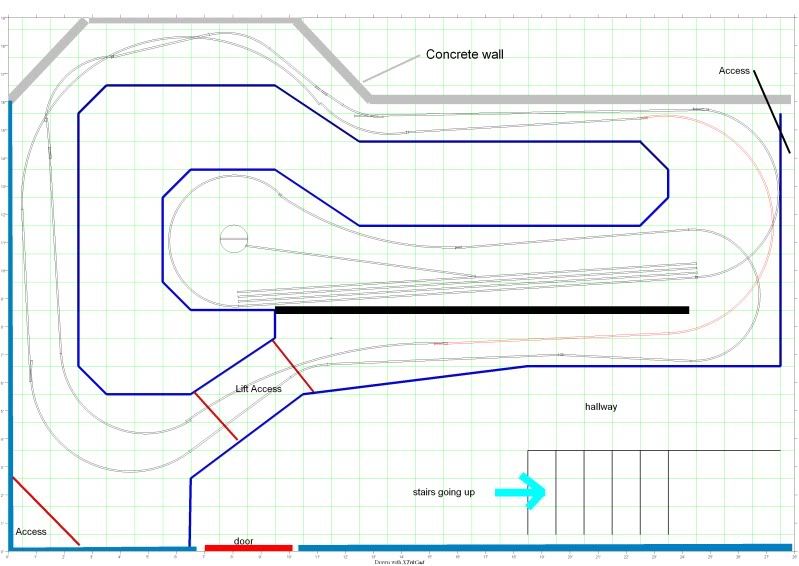Hello Everyone,
We have moved and it is time to start a new railroad.
I need ideas for the area in blue. I want to have 2 decks with hidden staging as a 3rd lower deck.
http://i63.photobucket.com/albums/h122/jwey71/layout12-12.jpg
Hello Everyone,
We have moved and it is time to start a new railroad.
I need ideas for the area in blue. I want to have 2 decks with hidden staging as a 3rd lower deck.
http://i63.photobucket.com/albums/h122/jwey71/layout12-12.jpg
Fixed your media insert so we can see it.
First of all, lets get some details out of the way. Are you a first time layout builder – because I’m struck by the ambition of your design. Most people embarking on something that big already have lots of experience with designing and building layouts. If you don’t, please consider scaling back your plans to something less extensive.
Can you add some details to the area above? What’s the scale? 1 block = 12"? Are the edges walls, or the boundaries of an area you’re “allowed” to use? What other obstacles are there, especially right at the edges, that might impede access.
And in order for anyone to be of any real assistance, WE’re the ones who need ideas. What and where are you planning to model? What era? What do you want on your layout – switching, continuous running, point-to-point operations?
You will get lots of help pulling your ideas together into a concrete whole, but generally, no one who will just throw together a layout for you based on a blank slate of a given size. So put YOUR brain to work, and lots of us with throw OUR brains behind yours.
Thanks for fixing the link
This will be 4-5th large layout
There are no obstacles within the blue area, the Top and Left are the walls
12" squares
Guess it helps when you add the Givens/Druthers
Railroad Name is unknown
Scale: HO
Prototype:
Era: Steam to diesel transition
Region: Mountainous
Railroad: Southern Pacific and Union Pacific
Space: utilizing 2 decks…3rd in future
Governing Rolling Stock: Coal and logging with a passenger run
Relative Emphasis:
|____V|
Track/Operation Scenic realism
|V|
Mainline Running Switching
Operation Priorities:
hi Southern,
my guess, here i go again, is you have been trying out lots, though you did not succeed in getting your wishes come true. If so, show us your best attempts and your worsts.
If you did not try anything yourself, pay someone a few 1000’s of dollars, he might want to be hired.
Best of luck
Paul
I think Paul’s point is valid, and here is why.
If you start with a blank slate, in this case the bare dimensions of a room, you are essentially asking others to design the layout and the track plan for you. If that isn’t an enormous task, in and of itself, when you provide the list of particulars that you have provided, it really becomes difficult to step in and design a plan.
I think that the best approach would be for you to make the first move and do some drawings of something that you might like and then ask for critique.
I hope that you will not be offended or put off by these responses, but from past experience, that makes a lot more sense than the blank slate approach.
Rich
The first thing that comes to mind is “what a messed up space”. The total square looks to be about 28 feet long and 20 feet high. Does that sound right? Can you use it all?
Is the area in blue what you are limited to, or is it what you want your benchwork to look like? You have left open areas on the upper wall. What are they for?
Sometimes the benchwork has to be kept in a specific area, but the operators can be outside of that area because they are not permanent.
The optimum benchwork design is usually about two feet wide because that is what you can reach across comfortably. The running length of that is usually placed against the walls for a layout that goes around the room with maybe a peninsula or two sticking out from it that has access to two sides and the end.
It might be better to show us the room with any objects that you have to work around. Include windows, doors, and furniture if it is a family room that has to be shared with other people.
I didnt mean for anyone to “design” the layout. Just looking for input as to where to locate the loops.
I played around and came up with this, the benchwork is the darker blue
The Top and left have walls, the center of the room can be adjusted

Do the stairs come into the room from a floor above or a floor below?
What is in the blank space on the top wall?
It is a messed up space, that why I am having a hard time for something to look right…
The top is the foundation wall. I am starting to think that a point to point is a better because using a 30" radius uses up so much room. I need to find a better way for the benchwork so it flows better

Another Thought

OK, I get it now. The stairs go up, the upper odd shaped wall is the outside foundation of the house, and there is an outside door in the room as well.
The first benchwork design is not bad. I don’t like the second one you call point to point. The room has potential and the thinking will have to be creative.
You are right about the curves being limited. My layout is set in the early diesel era (1962) and I have limited myself to the following: Small Steam for excursions; primarily four axle diesels or short six axle types; mostly 40 foot cars but some 50 foot; passenger cars are 60 foot. My minimum radius is 18 inches by choice and the equipment listed runs well on it.
Since I like a challenge, I may try and give you some more options for your benchwork if I can find the time.
OK, here is my suggestion:

There are three different layout levels on the upper wall. The lowest is for staging and can be six inches below the main level. Next up is the main layout, lower level. Then on top of that is the upper level. The Peninsula on the left is for the mountain region. The upper level can connect to this and track access can be with a helix. There is also two lift up access sections. Track work on these sections should be simple with no complicated track work or scenery.
I didn’t draw it to scale so some adjustment may be necessary to make your minimum radius fit. Somewhere around 24 to 26 inches should work. The peninsula may have to be wider for the helix. Once you get the bench work to fit your space, then you can start designing the track plan.
If you go to my web site you will find information on lift bridges. (The URL is in my signature block at the bottom. The lift-bridge link is on the page for my HO C&A RR.) I have four lift bridges on my layout, so they can be made easily and will line up all the time.
Hope this helps.
Here is my hack at this space:

Min radius is 30" with the loop in the lower left corner could go either to staging or second level. If you make the peninsula a continuous 2% grade you can end up with ~15" track to track separation between decks. Which would be enough separation that you could have a staging yard against the cement wall along the top of the plan. If you place the yard on the peninsula you can get ~10" of track to track separation against the back wall
The aisles spacing is 4’ with two pinch points of 33" and 36" around the end of the peninsula.
Chris
This looks like the best use of the space so far from an ease of operation and construction standpoint. However, if it was me I would make a bit of a change to the width of the isle ways and have a helix at each end. the helix would connect with a lower level that could be either staging, or another operating level depending on your preferences.
In the section marked alt route for placing yard here 2 feet could be taken from the isle on the side where the stairs are and added to the bench work. On the opposite side 1 foot could be subtracted from the isle and added to this bench work making the peninsula up to 6 feet wide, 5.5 would still allow the 30 inch minimum radius and would allow for an additional 6 inches of isle space on the side of the stairs if you think it is needed.
You could have a no duck under layout with lots of staging, or a two level layout with a long run and nice scenic elements. My choice would be staging on the bottom with 4 scenic elements on top at a fairly high level. Continuous running would be a possibility as well as prototypical operation when you desired. Also this layout could be constructed so it could be moved out in sections and likely reused in other locations if you were to move as it is not so huge that it would not fit the next basement or attic available.
hi Southern,
before going to the drawing board some questions or remarks:
2)On your plan the peninsula’s are 5 feet wide, aisles 2 feet; not really possible with a 30" radius. Are you willing to accept a 27 or 28 minimum radius?
3)The lower peninsula in the second plan could be extended further towards the door. Is this a NO-NO?
4)The two tracks leading into staging suggest they are connected by an underground staging area. Nice, but you do not give your idea’s how to climb to a second deck. Is a second deck something you really want? Having a severe grade at one end of the line, your “helper-district”, and a easy grade down again asks lots of length. I do not see how to combine this with continuous running and a second deck. A visible helper district up-hill to the second deck, a helix back down to staging?
5)With a staging area and two decks filled you will need quite a crew to operate your layout. Probably more then 5. Are you up to this and are your aisles appropriate?
7)Should one peninsula be dedicated to high mountain logging operations?
8)Is cutting through the stairs an option, just a 4 inches wide shelf along the lower wall only?
Just to illustrate some idea’s:

On the lower peninsula an extra connection could be made. Resulting in a loop-to-loop on the lowerdeck independent from a big oval on the upper deck.
Lots of question, with you best luck
Smile
Paul
Thanks for the ideas guys!!
gandydancer19: I like the idea of having the bench work continuous but I need to keep the door, free and clear, for the wife, so i can adjust that. I can use 1 lift access to get into the RR.
stilson4283: I like the idea of getting the lift to the 2nd deck
J.Rob: I will add your ideas into the next re-draw and will keep in mind to make it easier to disassemble. Though I dont plan on moving…again
Paulus Jas**:**
2)I would like to keep 30" rad. but I can goto 28" if needed. Aisles need to be kept at 3’…but can squeeze in some areas.
4)Is a second deck something you really want? Yes, I want to build it so I can expand once the main area is running. I would like to keep the “helpers” in there but am trying to stay away from a Helix.
5)It will be mostly a “family crew” of 3-4 so I need to keep 3’ aisles
7)The logging was planned on being more of the 2nd deck, maybe with some coal areas.?
8)Is cutting through the stairs an option.hmmmmm Id need to think how to negotiate with the wife…maybe more flower gardens in the screen…LOL
I will try to add all of your ideas and come up with something today
THANKS for all the input!!!
Southern 4449:
See? I told you you’d get lots of help if you started the, er, train moving (sorry, couldn’t pass on the bad pun).
I’m looking forward to your next redraw and see where you are. I’ll hold off on suggestions until then, because you’ve got a lot of good material to work with!
One question, because I think I misunderstood originally: Do you want one level of actual layout, or two? Are you counting the staging as part of the second level, or will that make a third? (OK, that’s kind of two questions…)
I am wanting to have a total of 3 levels. The first lower level (hidden) would be staging, the 2nd would be the main layout, and the 3rd would be a shelf style above that has logging/mining that would require “helper service”. The main level would be continuous running with some switching and have branch lines for mostly switching.
I wasn’t to concerned about the track this morning just trying to get the bench work flowing

I would be concerned about the idea of having the yard in the middle of the peninsula. The general rule of thumb is to keep track no more than 30" from end od the benchwork. With that in mind I would rethink the design in the middle of the peninsula.
Chris
For my money, you’ve got that bass-ackwards: you should worry about the track first, then design benchwork under it. Obviously, one will follow the other, but don’t let a benchwork plan limit your creativity.
I like where you’re going with this – but you still have some serious access issues, most notably the center of that lower right area and the whole area to the right of the turntable – as Chris rightfully points out. For actually doing scenery / layout work, a topside creeper-type device will be fine to reach them, but that’s a lot of bother to use to fix derailments or other operating issues. The best most of us can do is 30", unless you’re unusually tall or long-armed.
On this plan, I see the continuous running flow; what I don’t see is level transitions. Is this done using a drawing program, or actual layout planning software (the 4 yard tracks in the center, for instance, are lacking a lot of turnouts / crossovers).
Southern, I like your plan so far. It looks like you have a nice long run around the room with your mainline.
(I actually design my bench work first too, and then go for a track plan. It can be done either way and depends on how creative and flexible you are. Also, when I do a track plan, it is just a rough sketch. When I go to lay it out, I use actual pieces of track and work the final arrangement as I lay it down marking the center lines.)
I think I would opt for a wye that goes into the yard and service area and maybe forget about the mainline making a loop in there unless using a smaller radius. That way you can narrow down the bench work some where the yard is.
It also looks like you could put a one turn helix in the lower left (going around the outside of a mountain) to start a grade to an upper level. Remember, a helix doesn’t have to have the same radius throughout, so you could even put in two turns on the mountain side. (A larger radius near the bottom and smaller radius above it.) And since you are talking about a logging / mining branch, the radius doesn’t have to be as large as the mainline. (I use a no-lix to get to a second level.)